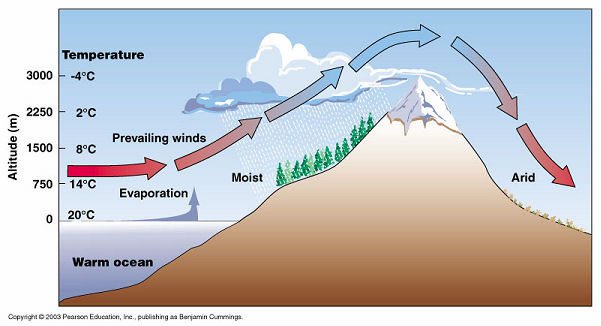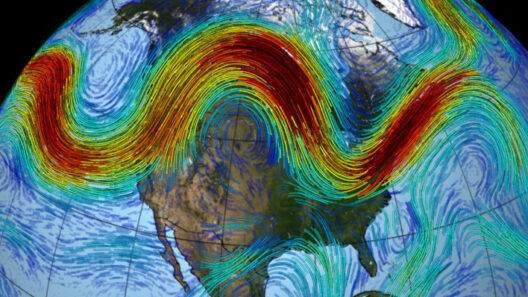Mountains are awe-inspiring natural formations that dominate landscapes and profoundly influence the climate of their surroundings. Their grandeur captivates our imagination and serves as a reminder of nature’s power and complexity. One common observation is that mountainous regions often exhibit markedly different weather patterns compared to adjacent lowlands, leading many to ponder the underlying reasons. This article delves into the intersection between mountains and climate, elucidating how these majestic structures act as nature’s weather walls and shape regional climates.
To understand how mountains impact climate, one must first grasp the fundamental principles of orographic lifting. Orographic lifting occurs when moist air encounters a mountain range and is forced to ascend. As the air rises, it cools, leading to condensation and precipitation on the windward side of the mountains. This phenomenon explains why mountainous regions frequently receive significant rainfall, nurturing lush ecosystems and diverse flora and fauna. However, the process does not end with precipitation; the air, now depleted of moisture, descends on the leeward side, creating what is known as a rain shadow.
The rain shadow effect is a striking demonstration of the mountains’ role as barriers to atmospheric moisture. As the air descends on the leeward side, it warms adiabatically, resulting in drier conditions and often arid landscapes. This stark contrast between the windward and leeward sides encapsulates the mountains’ dualities in climate—where abundance meets scarcity in close proximity, leading to biodiverse ecosystems coexisting with stark desert-like environments.
Consider, for instance, the Sierra Nevada mountain range in California. The western slopes receive copious amounts of rainfall, fostering lush coniferous forests. In stark contrast, the eastern slopes descend into the arid expanse of the Great Basin, characterized by scrublands and sparse vegetation. This transitions elegantly highlight the cascading climatic narratives that mountains generate, affecting not just landscapes but also human settlement and agricultural practices.
Moreover, the relationship between mountains and climate is not solely about precipitation. Elevation plays a pivotal role in determining temperature gradients. As altitude increases, the atmosphere becomes thinner, leading to cooler temperatures. This phenomenon, known as the environmental lapse rate, can create microclimates within mountainous regions. For example, a single mountain can host a variety of climatic zones, ranging from temperate forests at lower elevations to alpine tundra near the summit. Such variations permit an impressive array of biodiversity, tailored to specific environmental niches.
Additionally, the geographic orientation of mountain ranges can influence prevailing wind patterns, further modulating climate. For example, in the case of the Himalayas, these colossal mountains act as a formidable barrier to the cold winds of Central Asia, conferring a more temperate climate to the Indian subcontinent. On the flip side, their presence also contributes to the monsoons—a season marked by heavy rainfall that is vital for agriculture in the region. This intricate interplay of atmospheric dynamics underscores the importance of understanding mountainous regions not as isolated systems but as integral components of larger climatic patterns.
As scientists investigate these mountain-climate interactions, they also uncover the broader implications of climate change. The effects of global warming are viscerally experienced in mountainous areas, where glaciers are receding at alarming rates. These glaciers serve as critical water sources for millions of people, and their decline raises concerns about water availability in downstream regions. Furthermore, alterations in snowfall patterns and the frequency of extreme weather events pose additional risks for mountain ecosystems, affecting everything from vegetation to wildlife habitats and even human livelihoods.
In addition to the environmental impacts, the cultural and socioeconomic dimensions of mountains and climate are equally compelling. Mountain communities often have developed intricate lifestyles shaped by their environments. Traditional agricultural practices are finely attuned to the unique climatic conditions that mountains impart. Seasonal shifts in weather influence crop cycles, while access to resources may dictate patterns of trade and cultural exchange. Therefore, understanding how mountains affect climate also requires appreciating the rich tapestry of human interaction with these formidable landscapes.
One cannot overlook the aesthetic and recreational allure of mountainous regions. The striking contrasts in climate and landscape invite a plethora of recreational activities, from skiing in snowy resorts to hiking through verdant valleys. These activities foster a deep appreciation for nature—the mountains not only provide economic opportunities through tourism but also inspire a sense of environmental stewardship as people engage with and seek to protect these magnificent landscapes.
In conclusion, mountains significantly influence climate through mechanisms such as orographic lifting and the rain shadow effect. Their presence leads to diverse ecosystems, intricate microclimates, and essential water resources, which are vital for human survival. As the existential threats posed by climate change loom larger, understanding these dynamics becomes increasingly crucial. From nurturing rich biodiversity to shaping human cultures and economies, mountains are not merely geological features; they are dynamic entities that have profound implications for our planet’s climate system. As stewards of the environment, recognizing and responding to the impact of mountains on climate must be a priority for preservation and sustainability efforts across the globe.








